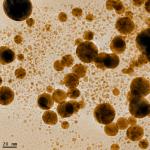Electrophoretic Light Scattering (ELS)

Electrophoretic Light Scattering (ELS)
Particles usually carry charges on the surface in aqueous systems, surrounded by counterions that form a firmly inner Stern layer and an outer shear layer. Zeta potential is the electrical potential at the interface of the shear layer. A suspension system with higher zeta potential tends to be more stable and less likely to form aggregates.
Electrophoretic light scattering (ELS) is a technology for measuring electrophoretic mobility via Doppler shifts of the scattered light. When an incident light illuminates dispersed particles that are subjected to an applied electric field, the frequency of the particles’ scattered light will be different from the incident light due to the Doppler effect. The frequency shift is measured and converted to provide the electrophoretic mobility.

Phase Analysis Light Scattering (PALS)
The traditional ELS converts the correlated scattering signals into frequency distribution and then calculates the frequency shift of the scattered light, compared with the reference light. Phase analysis light scattering (PALS), an advanced technology based on the traditional ELS technology, has been further developed to measure zeta potential and its distribution of a sample.
By analyzing the phase information of the original scattered signal, PALS obtains the frequency information of that light. The phase shift with time is proportional to the frequency shift.
PALS technology can suppress the influence of the Brownian motion of particles on the results, thereby providing higher statistical accuracy. In various applications, PALS can effectively measure the zeta potential of particles whose charge approaches the isoelectric point, for instance, particles with very slow electrophoretic mobility at a high salt concentration.
3P Instruments provides a PALS-based instrument as a part of the 3P Bettersize BeNano series nanoparticle size and zeta potential analyzers.

